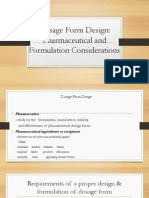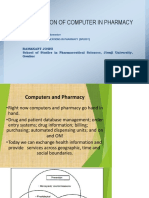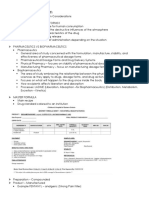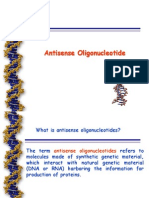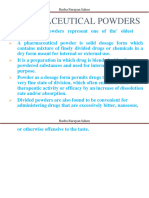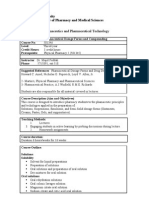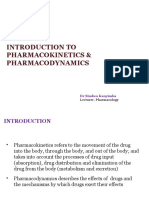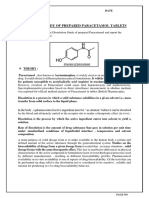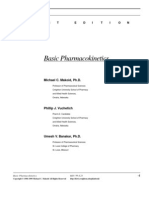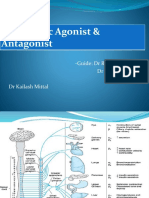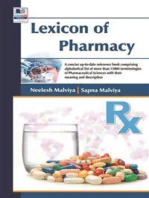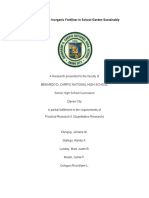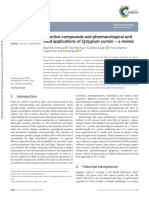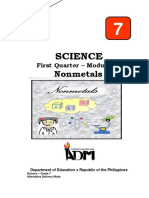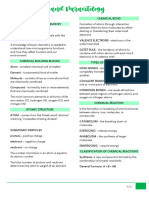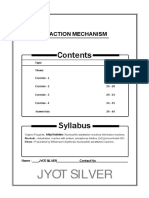Dosage Form Design
Uploaded by
NICOLE ANGELIQUE M. DINOYDosage Form Design
Uploaded by
NICOLE ANGELIQUE M. DINOYDrug Dosage Form Design
Dosage Form ROUTES OF ADMINISTRATION
Dosage forms are meant by which drug 1. Oral
molecules or delivered to sites of action Tablets
within the body to produce desired Immediate-release (IR)
therapeutic effects and minimum adverse Enteric -Coated (EC)
effects Sprinkles & Granules
It is the combination of API and Excipients. Effervescent tablets
API is the chemical compound intended for Orally- Disintegrating (ODTs)
used in treatment and prevention of Controlled or Sustained Release
disease. Sublingual
Excipients are inactive pharmaceutical Capsules
ingredients technological, Hard Gelatin
biopharmaceutical/ or stability reasons. Soft Gelatin
2. Topical / Transdermal
Why Dosage Forms? Transdermal Patch
Safe and convenient delivery of accurate Creams
dosage Ointments
Protection from the atmosphere Gels
Protection from the gastric acid (EC tablet)
Masking bitter, salty, or offensive taste or 3. Parenteral
odor Intravenous
Liquid formulation for insoluble and Subcutaneous
unstable drugs Intradermal Injections
Rate- controlled drug Action Intramuscular Injections
Topical drug action Intraspinal Injections
Drug insertion into body cavity Intrathecal
Drug placement into bloodstream Epidural
For inhalation Therapy 4. Rectal
Suppositories
Rectal ointment & creams
CLASSIFICATION OF DOSAGE FORMS Enemas
Rectal Foams
Immediate 5. Vaginal
Release Release Tablets
rate Suppositories
Modified or Timed-Release Creams
Ointments
6. Ophthalmic / Ocular
Solutions
Ointments
Extended Release Delayed Release Suspensions
Examples
7. Pulmonary
8. Nasal
Controlled Release Sustained Release Targeted
release
State of Dosage form WORK FLOW Of Pre-formulation Studies
1. Solid
Tablets
Capsules
Powders
2. Semi-solids
Creams
Ointments
Gels
3. Liquids
Monophasic
Syrups
Biphasic
Suspension
Emulsions
4. Gas
Nebulized solutions
Aerosols
Packaging
1. Unit Dosage Forms
Tablets
2. Bulk Dosage Forms
Powders
Pre-formulation Consideration
Physical Consideration
WHAT IS NEEDED TO DESIGN A DOSAGE FORM? Microscopic observation
1. Pre- formulation Studies Macroscopic observation
2. Stability Studies Particle size and shape
PRE- FORMULATION STUDIES Solubility
It is defined as the phase of research and Polymorphism
development in which physical and Physical form (crystal/ Amorphous)
chemical properties of drug molecule in Flow properties
order to develop safe, effective and stable Chemical Consideration
dosage form. Hydrolysis
It is the first step in rational dosage form Oxidation
development substances Reduction
It is performed based on dosage forms to Racemization
be developed. Polymerization
OBJECTIVE OF PRE-FORMULATION STUDIES Isomerisation
To establish the physico-chemical Photo stability
parameters of a new drug entity
To determine its kinetic and stability
To establish its compatibility with
common excipients
It provides insights into how drug
products should be processed and
stored to ensure their quality
The purity of the chemical substances is Melting Point depression
essential for its identification as well as for the A characteristic of a pure substance is
evaluation of its chemical, physical, and defined melting point or melting range.
biological properties. If not pure, the substance will exhibit a
depressed melting point.
This phenomenon is commonly used to
Chemical Structures, form and
determine the purity of a drug
Properties reactivity
substances before inclusion in the same
dosage form.
Physical Physical description, Melting point or Freezing point
Properties Particle size, Crystalline Defined as the temperature where the
structure, Melting point, pure liquid and solid exist in
Solubility. equilibrium.
The melting point / range of a drug can be used
Biologic Ability to get a site of as an indicator of purity of chemical substances
properties action, Elicit a biologic (a pure substances would ordinarily be
response characterized by a very sharp melting peak.)
An altered peak or a peak at a different
temperature may be indicative of an
Physical Form adulterated or impure drug.
Before the formulation of a drug substances into a
dosage form, it is essential that it will be chemically and Particle Size
physically characterized. Certain physical and chemical
properties of drug substances are
affected by the particle size distribution,
including drug dissolution rate,
bioavailability, content uniformity,
taste, color and stability.
In addition, properties such as flow
characteristics and sedimentation rates,
among others, are also important
factors related to particle size.
Polymorphism
An important factor on formulation is
the crystal or amorphous form of the
drug substance. Polymorphic forms
usually exhibit different physio-
chemical properties including melting
point and solubility.
Microscopic examination The changes in crystal characteristic can
Microscopic examination of the raw influence bioavailability, chemical and
drug substance is an important step in physical stability, and have important
pre-formulation work. implications in dosage form process
It gives an indication of particle size and functions.
particle size range of the raw materials
as well as the crystal structure.
Solubility Solubility and pH
A drug must possess some aqueous pH is one of the most important
solubility for therapeutic efficacy. factors involved in the
For a drug to enter the systemic formulation process. Two areas
circulation to exert a therapeutic effect, of critical importance are the
it must first be in solution. effects of pH on solubility and
Relativity insoluble compounds often stability.
exhibit incomplete or erratic The effect of pH on solubility is
absorption. critical in the formulation of
If the solubility of the drug substance is liquid dosage forms, from oral
less than desirable, consideration must and topical solutions to
be given to improve its solubility. intravenous solutions and
Solubility and particle size admixtures.
Although solubility is normally Dissolution
considered a physiochemical Dissolution rate can affect the
constant, small increases in solubility onset, intensity, and duration of
can be accomplished by particle size response, and control the overall
reduction. bioavailability of the drug from
the dosage form.
The dissolution rate of drugs
may be increased by decreasing
the drug’s particle size.
It may also be increased by
increasing its solubility in the
diffusion layer. The most
effective means of obtaining
higher dissolution rates is to use
a highly water soluble salt of the
parent substance.
Membrane permeability
To produce a biological
response, the drug molecule
must first cross a biological
membrane.
The biological membrane acts as
a lipid barrier to most drugs and
permits the absorption of lipid
Solubility and pH soluble substances by passive
pH is one of the most important diffusion while lipid insoluble
factors involved in the formulation substances can diffuse across the
process. barrier only with considerable
The effect pf pH on solubility is difficulty
critical in formulation of liquid
dosage forms, from oral and topical
solutions to intravenous solutions
and admixtures.
Partition coefficient
In formulation development, the Stability Studies
octanol-water partition Stability studies conducted in the
coefficient is commonly used it is pre- formulation phase based on
the indication of drug solubility Chemical Consideration.
profile in water and octanol
Following the illustration provided above, it is defined
as
Solid-state of the drug
alone
Solution Phase
with the expected excipients
[P is dependent on the drug concentration only if the
Drug and Drug Product Stability
drug molecules have a tendency to associate in
solution. Higher P value higher permeability and higher
bioavailability]
Physical and chemical stability of
pKa/ Dissociation constants Evaluation pure drug substances important
Extent of ionization has an for pre-formulation.
important effect on the
formulation and
pharmacokinetic parameter of Drug Mechanism of
the drug.
Stability Degradation
The extent of dissociation/
ionization is, in many cases,
highly dependent on the pH of
the medium containing the drug. Hydrolysis
In the pharmacokinetic area, the
extent of ionization of a drug is
an important factor of its extent
of absorption, distribution, and Hydrolysis (solvolysis
process)
elimination.
Dissolution constant or pka is
usually determined by
potentiometric titration.
Susceptible to he
(drug) molecules
hydrolytic process :
interact with water
esters, substituted
molecule to yield
amides, lactones, and
breakdown product.
lactams.
Oxidation Decarboxylation
Is a chemical reaction that
removes a carboxyl group and
release carbon dioxide (CO2).
Loss of electrons from Usually, decomposition of
an atom or molecule.
RCOOH
aldehyde, alcohols,
phenols, sugars,
Free radicals
alkaloids &
unsaturated fat & oils.
Racemization
Racemization refers to partial
conversion of one enantiomer Deamination
into another resulting in loss of Removal of nitrogen containing
biological activity. amino group from organic
Conversion of optically active amine.
compound into inactive
compound.
It affects solubility, dissolution,
absorption and bioavailability of
drug.
L- epinephrine is 15-20 times
more active than D-form while
racemic mixture has half of
inactivity than L-form.
Polymerization
Any process in which relatively
small molecules, called
monomers, combine chemically
to produce a very large chain like
or net work molecule, called a
polymer. The monomers
molecules may be all alike, or
they may represent two, three, Drug Instability Detected by
or more different compounds. Physical Appearance
Color
Odor
Taste
Texture of the
formulation
Fig. Paraformaldehyde
Oxidizable drugs Stabilized in Stability Testing
Formulation
1.) Accelerated 2.) Short term 3.) Long term
Exclusion Inclusion Stability accelerated stability studies
Oxygen Maintain a testing/Stress studies
favorable pH Testing
Oxidizing agents Antioxidants
Trace metals Chelating agents When real time Determines most Product is
Light Buffering agents data is stable of the subjected to
unavailable it is proposed different
Heat
performed for formulations for climatic zones
Other chemical shelf life a drug product
catalysis (temp. &
determination. lesser temp and
Accelerated humidity. humidity)
stability study is nationally &
Hydrolysable Drugs Stabilized in subjecting the internationally
Formulation. product to an predicted from
Reduction For
elevated level of the data
For certain
and the unstable antibiotic hydrolysable stress like generated from
elimination In Liquid In certain drugs the pH
of water for preparations injectable drugs, when an
of optimum
controlled continuing
aqueous
solid products
preparation is
stability. changes in stability studies
preparation
desired temperature or 12 months
humidity and
minimum.
By applying Water Anhydrous Use Dry form Between light.
a water replaced or vegetable
proof reduced in oils may be for pH 5 and
protective the used as the reconstitution 6, Use of
coating. formulation. drug's buffering Study Storage Minimum time
solvent agents.
condition period covered
By Use of
by data at
Powder
enclosing substitute for submission
and liquid-
maintaining injection Long term 25°C ± 2°C / 12 months
glycerin,
the drug in
propylene 60% ± 5% r.h. or
tightly
closed glycol, and 30°C ± 2°C /
containers. alcohol.
65% ± 5% r.h.
Intermediate 30°C ± 2°C / 6 months
65% ± 5% r.h.
Trace metals in drug stabilized by completing or Accelerated 40°C ± 2°C / 6 months
binding metal by using specialized agents 75% ± 5% r.h.
(chelating agents- Cadisod edetate & EDTA)
Container and solvent are source of difficulty in
preparing stable solutions of oxidizable drugs
which is eliminated by purification of source of
contaminant
Light catalyst to oxidation reactions
preparations packed in light resistant or opaque
containers can enhance stability.
You might also like
- Unit 2 Solid and Liquid Dosage Forms: StructureNo ratings yetUnit 2 Solid and Liquid Dosage Forms: Structure19 pages
- Scope of Pharmacy Education: A Concise Presentation byNo ratings yetScope of Pharmacy Education: A Concise Presentation by26 pages
- Cytotoxic Drugs: Pharm. Dr. Ezekiel EfeobhokhanNo ratings yetCytotoxic Drugs: Pharm. Dr. Ezekiel Efeobhokhan24 pages
- Novel Drug Delivery System Thakur Publication B Pharm 7th Semester-CompressedNo ratings yetNovel Drug Delivery System Thakur Publication B Pharm 7th Semester-Compressed114 pages
- Microspheres: BY, Divya Thakur, Mpharmacy (I.P), 1600-4P-1304No ratings yetMicrospheres: BY, Divya Thakur, Mpharmacy (I.P), 1600-4P-130432 pages
- THEORIES OF DISPERSION AND PHARMACEUTICAL DISPERSION(EMULSIONNo ratings yetTHEORIES OF DISPERSION AND PHARMACEUTICAL DISPERSION(EMULSION34 pages
- Pharmaceutical Dosage Forms and CalculationNo ratings yetPharmaceutical Dosage Forms and Calculation3 pages
- Prescription Handelling at Retail Level and Record KeepingNo ratings yetPrescription Handelling at Retail Level and Record Keeping24 pages
- Formulation & Evaluation of Sustained Release Microsphere of PropanololNo ratings yetFormulation & Evaluation of Sustained Release Microsphere of Propanolol11 pages
- Pharmaceutical Technology Lecture-12 - Dextrose Based SyrupNo ratings yetPharmaceutical Technology Lecture-12 - Dextrose Based Syrup21 pages
- Pharmaceutics-Practical-II-Lab-Manual-FinalNo ratings yetPharmaceutics-Practical-II-Lab-Manual-Final52 pages
- Micellar Solubilization: By:-Aakashsoni M.Pharma I Sem. Delhi Pharmaceutical Sciences and Research UniversityNo ratings yetMicellar Solubilization: By:-Aakashsoni M.Pharma I Sem. Delhi Pharmaceutical Sciences and Research University16 pages
- 1-En-Introduction To Pharmaceutical Technology and Mixing100% (1)1-En-Introduction To Pharmaceutical Technology and Mixing72 pages
- Introduction To Pharmacokinetics PharmacodynamicsNo ratings yetIntroduction To Pharmacokinetics Pharmacodynamics28 pages
- Adrenergic Agonist & Antagonist: - Guide: DR R K Solanki Sir DR Neelam Mam DR Kailash MittalNo ratings yetAdrenergic Agonist & Antagonist: - Guide: DR R K Solanki Sir DR Neelam Mam DR Kailash Mittal83 pages
- Feedback Regulated Drug Delivery SystemNo ratings yetFeedback Regulated Drug Delivery System17 pages
- Recent Advancement in Drug Technology1 ChabgesNo ratings yetRecent Advancement in Drug Technology1 Chabges45 pages
- Structural Classification of Drugs: A Quick Reference GuideFrom EverandStructural Classification of Drugs: A Quick Reference GuideNo ratings yet
- Exercises in Organic Synthesis Based on Synthetic DrugsFrom EverandExercises in Organic Synthesis Based on Synthetic DrugsNo ratings yet
- Extraction of Vesivirus Rna: 1. Prepseq Nucleic Acid Extraction KitNo ratings yetExtraction of Vesivirus Rna: 1. Prepseq Nucleic Acid Extraction Kit5 pages
- Color and Chemical Constitution of Natural Dye Henna (Lawsonia Inermis L) and Its Application in The Coloration of TextilesNo ratings yetColor and Chemical Constitution of Natural Dye Henna (Lawsonia Inermis L) and Its Application in The Coloration of Textiles9 pages
- Multiple Choice Questions (MCQ) Topic Quiz 4.2 Alcohols, Haloalkanes and AnalysisNo ratings yetMultiple Choice Questions (MCQ) Topic Quiz 4.2 Alcohols, Haloalkanes and Analysis11 pages
- The Skin Barrier and Moisturization: Function, Disruption, and Mechanisms of RepairNo ratings yetThe Skin Barrier and Moisturization: Function, Disruption, and Mechanisms of Repair12 pages
- Organic Farming: Submitted To: Submitted byNo ratings yetOrganic Farming: Submitted To: Submitted by17 pages
- (eBook PDF) Organic Chemistry 7th Edition by William H. Brown download pdf100% (1)(eBook PDF) Organic Chemistry 7th Edition by William H. Brown download pdf50 pages
- TCP I Two Marks Question With Answer Unit IiNo ratings yetTCP I Two Marks Question With Answer Unit Ii12 pages
- Difference Between Aerobic and Anaerobic Respiration: April 2017No ratings yetDifference Between Aerobic and Anaerobic Respiration: April 201712 pages
- AQA AS Chemistry 13 practice question answersNo ratings yetAQA AS Chemistry 13 practice question answers3 pages
- Chemistry Option F: Food Dyes and PigmentsNo ratings yetChemistry Option F: Food Dyes and Pigments2 pages
- AGM 301-Agricultural Microbiology (1+1)No ratings yetAGM 301-Agricultural Microbiology (1+1)24 pages
- Chemical Compatibility Results From Cole-Parmer IndiaNo ratings yetChemical Compatibility Results From Cole-Parmer India2 pages

